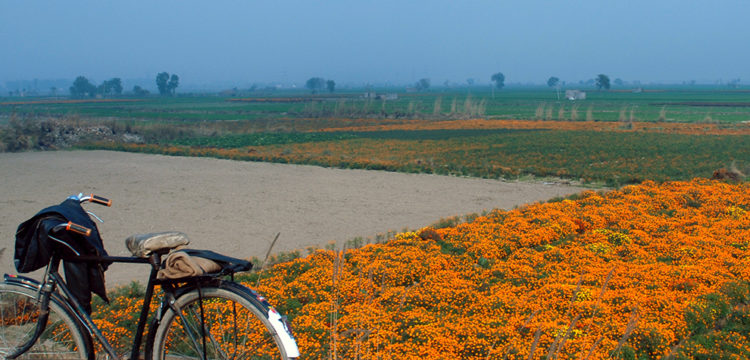Against the Normalization of Impunity
When systems benefit rulers: a conversation with Navjot Altaf on her work “Trail of Impunity”
Shaheen Bagh is a district in South Delhi. It has a population of almost 3 millions people, most of them Muslims. During the last few weeks, this district gradually became one of the main theaters of resistance operations and practices against the amendment of the Citizen Law, recently approved by the Indian Parliament. The amendment, proposed and promoted by BJP (Bharatiya Janata Party), the main Hindu Nationalist political subject, actually ruling the country, grants Indian citizenship to migrants from Pakistan, Bangladesh and Afghanistan. But there’s one condition to obtain citizenship: you can’t be Muslim. In India, Islam is practiced by 13.4% of the population, that means a huge number of people. The new legislation has been accused of threating the secular spirit of Indian Constitution: from the amendment’s approval, millions of people joined massive waves of protests and riots, from Muslim to Hindus, from students and intellectuals to Bollywood celebrities, facing brutal police repression, fighting what has been defined as the shameless Prime Minister Narendra Modi’s attempt to build the bases of a pure Hindu country. Such an attempt, today is operated through the construction of an inlet filter, a structural bureaucratic door policy discriminating on the basis of religion.
This persecutory attitude towards Muslims has many antecedents in India’s recent history and it’s definitely not the first time we see the involvement of Modi himself. In 2002, Modi was not Prime Minister, but he held the position of Chief Minister of Gujarat, a state on the Western coast of India. On February 28th 2002, the Muslim district of Ahmedabad, the largest city of Gujarat, had been invaded by an angry mob coming from the Hindu community. They started to set fire to bicycles and cars, and then attacked anyone who came across them with sticks, weapons and bottles of flammable substances. Violence culminated with 790 Muslims and 254 Hindus official casualties and more than 2500 injured. Among them, Ehsan Jafri, a member of Congress who has long been engaged in delicate and fundamental mediation activities between the Hindu and Islamic communities.
The violence began after a train carrying Hindu pilgrims caught fire, killing more than 50 passengers. It happened on September 27th, the day before the pogrom. Modi government blamed the incident on Muslim fundamentalists and let Hindus vent out their anger resulting in torture, rapes and killings. The Gujarat pogrom is the core issue of Trail of Impunity, a film realized by Indian radical artist Navjot Altaf. The work is part of Samakaalik, her recent solo show at PAV Turin, curated by Marco Scotini. Samakaalik represents a new chapter in a series of exhibitions focused on the relationship between artistic practices and ecological thought in the Asian continent. Here the attention is put on the Indian subcontinent, a particularly significant context as regards the exploitation of people and natural resources. Altaf, who is politically engaged since the 1970s—she took part in the Marxist collective PROYOM, Progressive Youth Movement—, brings to PAV her research which enlaces simultaneously (samakaalik in Hindi) struggles for environment protection and feminist movement—the intersectional phenomenon of ecofeminism. Her works tell us about mining exploitation and intensive farming, heavy industry and deforestation, reflecting on the cultural sovereignty of indigenous communities, in fight against the State authority and multinationals.
Trail of Impunity is a critique of violence. The video represents a long conversation between the artist Navjot, the journalist and civil rights activist Teesta Setalvad and the pogrom survivor Rupa Mody. Teesta Setalvad tells us about the capillary organization with which the assault is conducted: a degree of efficiency that suggests something else than an impromptu insurrection, prepared the same night by simple workers; for Teesta, there was a clear masterplan behind the Gujarat events and those who attacked the Islamic community were nothing more than material executors, instigated to commit violence and abuse by different figures. Powerful figures: it was no longer a conflict within the population, but a proper tool of repression, through which government officials, politics and police forces intentionally target minorities. Rupa Moody, who was at Ehsan Jafri’s house helping the injured, tells us about the police’s inertia in responding to their request for help. Navjot and Teesta Setalvad to look at the pivotal issues of ghettoization and the parallel oppression of minorities from a feminist standpoint, stressing on the peculiar ways in which violence strikes women. The protagonists dwell on the urgency to build active involvement processes, to intersect the perspectives of artists, social workers and community members at the core of the struggle.
“A culture of impunity is spreading around the world. ‘Try to stop me’ is the implicit motto in nations ranging from Hungary to Israel, Saudi Arabia to Russia, Turkey to China, Poland to Venezuela. Flaunting your disregard for the law is an expression of power” says a recent George Monbiot’s article published on The Guardian, in which he comments the political action of Modi as well as Bolsonaro, Trump, Duterte and ‘other killer clowns,’ using Monbiot’s words that is hard not to endorse. “The normalisation of impunity is possibly the most important step towards authoritarian rule. Never let it be normal.” Following, a conversation between artist Navjot Altaf and the exhibition’s assistant curator Giulia Mengozzi.
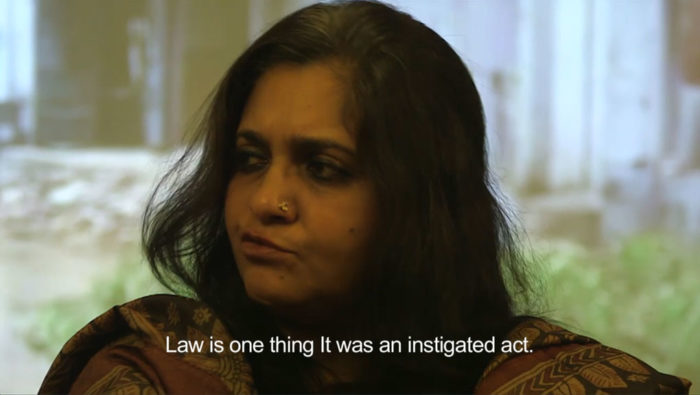
Navjot Altaf, Trail of Impunity (2014), 1h 48′. Courtesy the artist.
Giulia Mengozzi: Valorization of Indian indigenous cultures and, more in general, of coexistence between different cultures, it’s a recurrent theme in your practice. Could you articulate these aspects, in relation to the recursive attempts of Hindu nationalists, like Modi, to flatten India’s cultural complexity?
Navjot Altaf: Cultural diversity has been India’s distinguishing characteristic, and a source of strength for centuries. In the XV century, Sufi poets such as Kabir and Nanak, “denounced with equal zest the narrowness of religious sectarianism.” They resisted the cast, class, religious hierarchies and their writings remind the efforts they made in order to bridge the gaps between people from diverse cultures and religious beliefs.
I grew up under the influence of such philosophies and then I practiced them, all my life. I find these philosophies extremely relevant, even in present times. At the same time I defend secularism, because the idea of India as a composite and plural culture is affirmed by the Indian Constitution. I’d like to quote Romila Thapar, who, in her Indian Society and the Secular: Essays, points out that secularist discourse can’t be an a-historical paradigm. “Insistence on secularization” she writes “not only assures democratic culture in India but also highlights that religious fundamentalists are not different from the colonial masters who had a scant regard for democracy and democratic institutions… Hindutva’s attempt towards Syndicated Hinduism for order and control has taken clues from colonial policies… they draw on colonial interpretations of Hindu Muslim… generating two-nation theory.”
The 2002 Gujarat communal riots, have been proved the result of a conspiracy. Nonetheless Modi, as a Chief Minister, got away with no charges. Since 2014, BJP government majority worked out strategies: like fascists, they use control and intimidation—to control, they impose laws eschewing democratic procedures. They know how this attitude became a global phenomenon and that the same strategies are employed in many countries. They use and manipulate media: lying, cheating and spreading hate against specific communities. Whereas for politically progressive people as well as the common Indian, the Constitution has been a document of hope, providing scope and support to a deeper understanding of democracy.
The Citizenship Amendment Act (CAA), the National Population Register (NPR), and the National Register of Citizens (NRC) have been recently and quickly—too quickly—approved; all of those acts are unconstitutional, as they violate Constitution’s Article 14 that guarantees equality to all. According to the government, the legislators aimed to help the religiously persecuted individuals migrants from Bangladesh, Pakistan and Afghanistan, but they lack to mention the millions of refugees who reside in India for years, those who faced persecution in Sri Lanka during the civil war, the victims of Rohingya genocide and then the refugees from Nepal as well as the Tibetan Buddhists from China.
The situation is alarming. Landless workers, both men and women, indigenous and non-indigenous who migrated to the cities to find work and there contributed to build and maintain the city infrastructure, nomadic tribes, homeless people: all of them are Indians, but they won’t have access to legally acceptable citizenship proofs. All of them will be impacted. The insecurity of belonging nowhere could lead to traumas and mental disorders—and, right now, no one is thinking about it. So, all across India, people came together in the street to protest against the new laws—as they discriminate not only the Muslim community, but all those mentioned above. Many Indian states have rejected the acts.
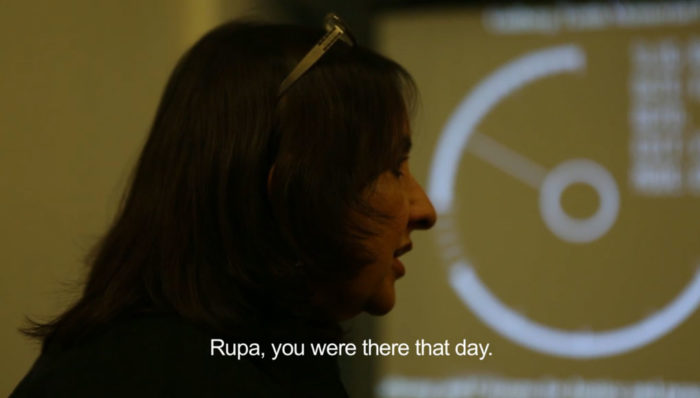
Navjot Altaf, Trail of Impunity (2014), 1h 48′. Courtesy the artist.
Do you think that artistic research and practices could, somehow, support the recent protests? What is your take on nowadays art and activism relationship, especially coming from extraordinary experiences like PROYOM and DIAA?
India’s recent protests include people from different generations, professions, religions and socio-economic-cultural backgrounds. They stand in solidarity against the Modi government’s dictatorial approach. One sees potential in the coming together of citizens. In the age of the Internet, people use phones to reach out and, everywhere, students and other protesters are exploring creative forms of dissent.
As an artist, I believe that art and artistic inputs have always paired and backed political struggles, especially when art engages itself in social contexts, imparting its liberating potential. We have seen this happening many times in history, all around the world.
Nowadays, combination of art and activism is recognized as a peculiar mode of art making, but in the 1970’s India, during PROYOM time, art and activism were seen as two different forms of commitment by the artists’ community as well as critics, but it did not matter anything to us.
Coming to our DIAA activities, which took place in the last sixteen years and include research in specific areas of Chhattisgarh and collaborations with the local indigenous artists and communities, have enhanced our sensibility towards processes that can create connection. Mainstream world knows very little about genuine grassroot politics and practices of resistance, practices elaborated by local people; they were and are the preservers of biodiversity throughout history. Over the centuries they opposed environmental destruction caused by deforestation, dams, roads widening, coal mining and other industrial projects. Koyla Satayagrah is one wonderful example. For them, ruined soil means that the soul is killed. Land is the base of indigenous communities’ lives and cultures. Development models adopted by governments, regardless of who or which party is in power, progressively destroyed them—systems benefit rulers.
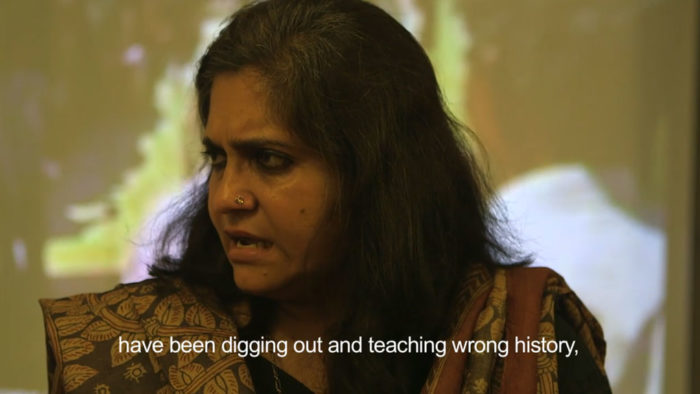
Navjot Altaf, Trail of Impunity (2014), 1h 48′. Courtesy the artist.
Concerning the recent protests, I happened to read an article recently published on Bloomberg Opinion. The author claimed that “protesters were harassed and detained with little cause. The courts seemed uninterested.” I immediately thought about Trail of Impunity, about the frightening idea of a seemingly irrational impossibility of justice. These days, it seems like people are using social media platforms to denounce the government’s unfair play, which was impossible in 2002—the Gujarat’s massacre year. With no intention to acritically praise the power of social media (that we should consider a very complex and controversial tool, at least), what do you think about this perspective?
See, it is not difficult to understand how authoritarian governments parlayed their power to control. We experienced such power in the mid 70s, during the Students Movement and the protests against the so-called emergency declared by then Prime Minister Indira Gandhi, back in 1975. Many progressive political activists and leaders, including a couple of PROYOM members, were arrested, jailed and brutally tortured because of our affiliations to the left party.
For all the three days of violence in Gujarat, in 2002, Modi ordered police officials to take no action against Hindu rioters. At that point BJP, was not even ruling as majority. The train incident was live covered on television for 24 hours; images of the burnt convoy and bodies were functional to the party’s own political usage, emoting people’s feelings. Investigations and legal proceedings against the ones involved in the riots took entire years, yet not all the victims got justice, despite the constant pressures from committed citizens and NGOs.
In August 2019, lawyers, students, local leaders, former Chief Ministers of Jammu and Kashmir, were arrested and placed under house arrest in the middle of the night, before BJP implemented a new bill, scrapping article 317 of the Constitution in order to separate the state of Jammu and Kashmir into two different Union Territories, against the autonomous powers that the territory possessed since independence. They didn’t even consult the state legislature of Kashmir. Newspapers have been completely censored. Until now, nothing suggests that things are coming back to normal, and civilians are in severe financial distress. The government prohibited visiting Kashmir, Internet access and phone lines shut down: no testimony, news or images of any local protests could circulate. Whereas social media, modern communication technologies play a crucial role in such moments. People can gain a voice, a tool to express their political opinions and practice decision making. On the other hand, in the last 3 or 4 years, the number of people using social networks has doubled and this factor helped BJP to get consensus, since they use social networks and digital communication as a tool able to mobilize public opinion through unofficial accounts.
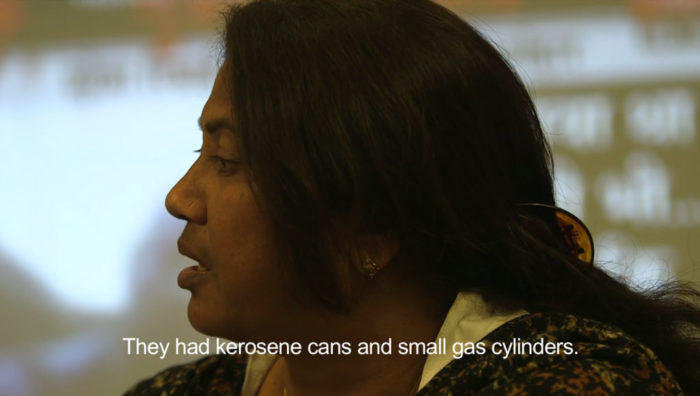
Navjot Altaf, Trail of Impunity (2014), 1h 48′. Courtesy the artist.
Recent student agitations (for example, in Jawaharlal Nehru University (JNU), Delhi) turned to violence because police took no prompt action against a right-wing student organisation (Akhil Bharatiya Vidyarthi Parishad, ABVP), spread through the whole country. ABVP is affiliated to Hindu nationalist Rashtriya Swayamsevak Sangh (RSS). Campus security, police and the administration, cooperated to allow ABVP goons to enter the premises. Non-violent protests of millions citizens across the country, opposed to CAA, NRC and NPR, have been disrupted many times by goons paid by the government. You see, we need to understand that these authoritarians have agendas: certain tactics are used to check to what extent their acts of inhumanity can be tolerated or eventually accepted by people. These tactics are nothing new to world history. Back in the 60s and 70s, the extremist right-wing party Shiv Sena had been allowed to grow in the State of Maharashtra, in the city then called Bombay, in order to eradicate the unions affiliated to the Communist Party of India (CPM), but the scale at which BJP is using media for their propaganda has no precedent.
But even in this kind of political situation, independent news channels like NDTV are providing critical perspectives, together with some fact checking web-sites, online portals and investigative outlets. I also feel that a new awareness concerning their fundamental constitutional and democratic civil rights is growing into the citizens. It won’t be easy for the government to force people to abandon their will to change the system, a system which is supposed to be run and owned by people. In my opinion, no matter which party is in power, we have to occupy and secure a space to deepen secularism.
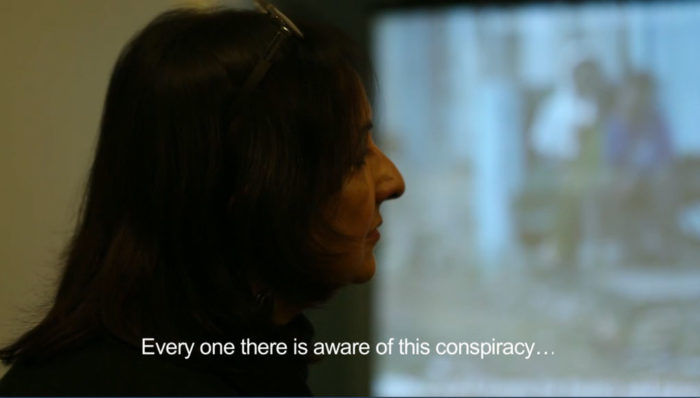
Navjot Altaf, Trail of Impunity (2014), 1h 48′. Courtesy the artist.
In a 2002 article (published in Italy by the weekly magazine Internazionale), writer and activist Arundhati Roy wrote that “Gujarat, the only big Indian State being governed by Bharatiya Janata Party, since a few years is the ground of a difficult political experiment led by Hindu fascism. Last month we saw the first public results of this experiment.” Do you think that the current Modi government’s full majority could be considered the result of a victorious political experiment that has its roots in Gujarat’s massacre? Can you try to explain, from your own point of view and in relation to Trail of Impunity, how could have been possible that a man so adamantly guilty of absolutely unethical actions have been elected as Prime Minister? I think it’s extremely important to think about those kinds of political figures and their strategies, since this is a plague that we find in many countries, from Italy to the US.
India is stated as a secular country in the Constitution, on the basis of its vast diversity, which means that “all religions have equal standing in the eyes of the law.” This is the principle the Bharatiya Janata Party is trying to seize, as in its beliefs and operations it remains an upper-caste Hindu state. So, this idea of one nation, one religion, one language is perpetrated by the minister of home affairs Amit Shah, who craves a Hindu Rashtra (Hindu polity). We should remember that Modi is a product of Rashtriya Swayamsevak Sangh (RSS), formed in the 20s. Its members were followers of fascist ideology and Muslims, according to the RSS, are nothing but outsiders.
In 2001, Narendra Modi was brought to Gujarat by the BJP central government to replace the then Chief Minister of Gujarat. All happened without passing through democratic elections. What happened in 2002 followed this pivotal passage, and as Arundhati points out, the experiment began. As mentioned in the video Trail of Impunity, Gujarat began to set in motion a whole new politics. And so politics of impunity entered our political system on a grand scale. Now, it is well known that 2002 riots have been, somehow, engineered; that enduring religious violence has been carefully prepared so that it could crush a particular community or other minorities. Modi hadn’t been suspended by the Prime Minister Vajpayee; instead, he won the next elections in a big way. BJP’S agenda focused on Hindu votes.
Another point I would like to make is how Modi re-etched his image, that of an industry, development friendly politician, with no concerns about environmental impacts. He invited big business firms to Gujarat, made land available. He used social media extensively and during campaigns he exceeded his constitutional rights, invoked Hindu sentiments, speaking often about Hindutva (Hinduness). He remained Chief Minister of Gujarat until 2014. So you see, he has come this far out of nowhere. All along, Bharatiya Janata Party was creating a leader with a specific agenda.
According to the court, no specific evidence has been found against Modi concerning the 2002 riots, despite a senior police officer’s sworn statement to the Supreme Court; he said that they allowed the riots to escalate, as they wanted Hindus’ anger to keep growing. This resulted in daylight gruesome killings and brutal rapes. It was possible only because of sanction and impunity.
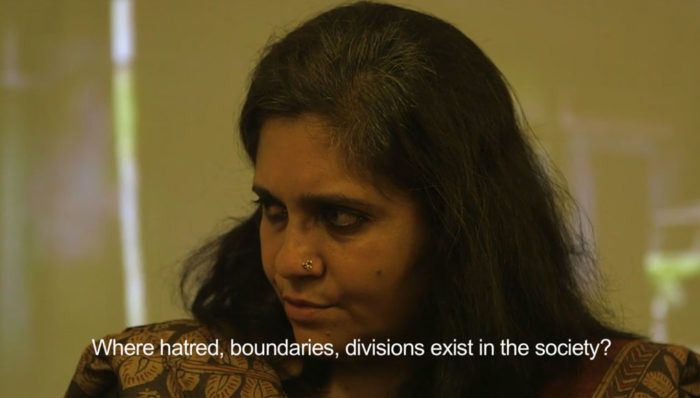
Navjot Altaf, Trail of Impunity (2014), 1h 48′. Courtesy the artist.
Trail of Impunity is an extremely intense, long dialogue between three women. How did you come to the decision that dialogue was the best way to represent this kind of unbearable violence?
When I first went to Ahmedabad, in 2002, a few months after the riots, it was through Teesta Setalvad, one of the participants in the video. She is a human rights activist who had worked in Gujarat since early 90s as a researcher and journalist and her organization Citizens for Justice and Peace had a branch in Ahmedabad. It was a really sensitive situation and without local volunteers, who had been constantly in touch with affected people, I could not have managed to meet the victims in transit camps, or other spaces in which they took shelter in, or eventually in places which had been badly damaged, or abandoned for safety reasons.
Intruding into spaces already pervaded by a sense of fear and uncertainty concerning unfamiliar outsiders, had never been my idea of research. So, the first few days I moved through the city with volunteers, wherever they were sent. Our dialogues as well as whatever I could see in the city—everything was disturbingly revealing and yet much remained hidden. Yet, I could sense the layered marks of violence, left everywhere we went to. Those were the areas badly affected and my mind began imagining the incurred loss: the notion of loss can have a different meaning for another person, a different generation, different gender, and then the different ways one does confront or cope with it, individually, socially, emotionally and psychologically. Later on, spending time with people in transit camps, listening to their testimonies and conversing with them in between was extremely significant for me. This way I’ve understood what cumulative grief could be. Rupa Moody lost her son and until this date she doesn’t know whether he is alive or not.
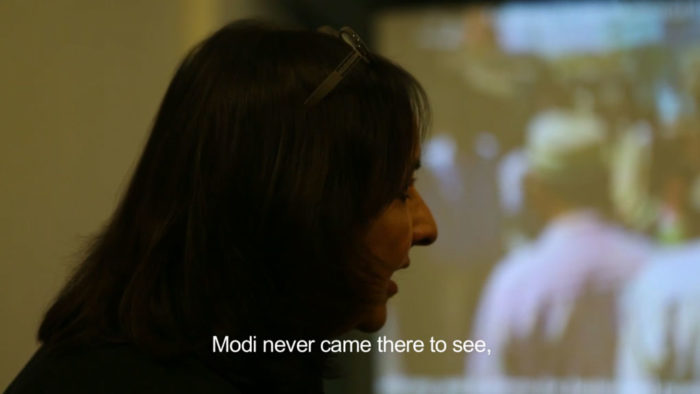
Navjot Altaf, Trail of Impunity (2014), 1h 48′. Courtesy the artist.
Twelve years have passed between Lacuna in Testimony, a work which evolved after 2002 and Trail of Impunity, made in 2014. The three of us, an artist, an activist and a survivor, had been engaged with the politics of Gujarat at different levels. As, at that time, Modi was BJP’s candidate for Prime Minister, in the context of 2014 Lok Sabha election, we were concerned about BJP’s idea of India. An idea in which composite culture, as we can see now, in 2020, is being forced to lose its dynamism, identity and existence.
To us, face to face dialogue was a form of shared conversation between three participants, which evolved spontaneously to come back to what he had done in Gujarat in 2001, in relation to what would happen in India in case of his electoral victory (we still see the consequences from 2014 onwards). This way, we’ve also been able to bring in the conversation our perceptions regarding our own political/secular positions and ideas.





